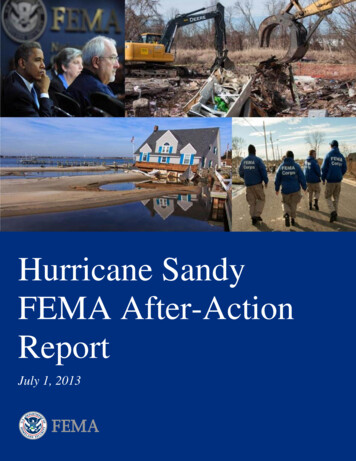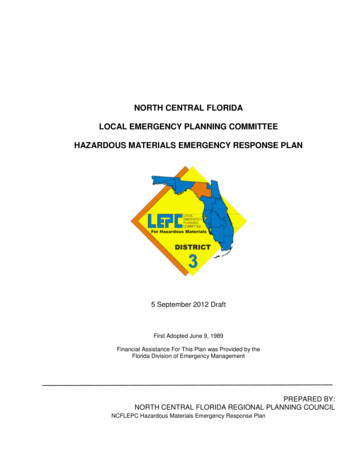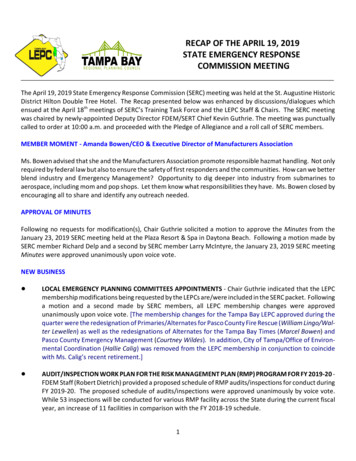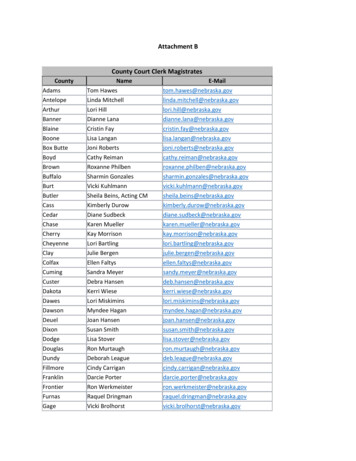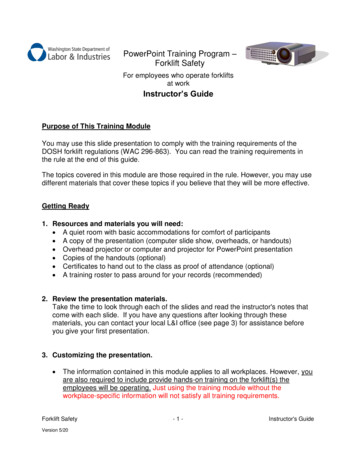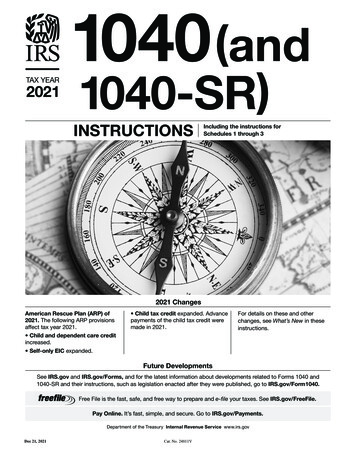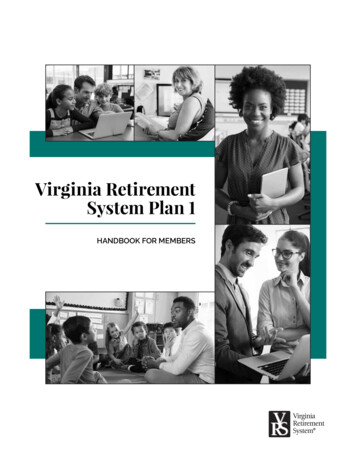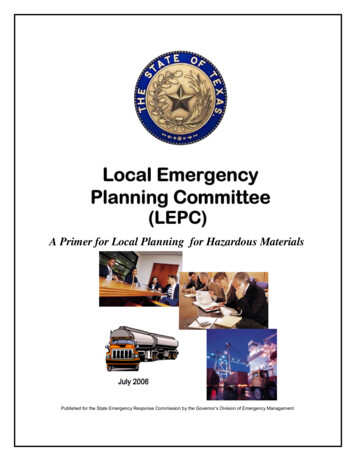
Transcription
Local EmergencyPlanning Committee(LEPC)A Primer for Local Planning for Hazardous MaterialsJuly 2006Published for the State Emergency Response Commission by the Governor’s Division of Emergency Management
Users of this Handbook are welcometo make additional copies. If you makeand distribute copies to other individuals,we suggest you keep a record of whoreceived them so you can also distributefuture changes to the document.Users of the Handbook are alsowelcome to abstract portions of theHandbook for use in local publications.If you use portions of the document,please credit your sourceRev. 07/06
PROMULGATIONThis revision of the Local Emergency Planning Committee (LEPC): A Primer forLocal Planning for Hazardous Materials is hereby approved for use. This revisionsupersedes all previous versions of this document and is effective immediately.July 26, 2006Jack ColleyChiefDateRev. 07/06
TABLE OF CONTENTSLOCAL EMERGENCY PLANNING COMMITTEE HANDBOOKPAGERECORD OF CHANGES .iiiACRONYMS/ABBREVIATIONS. ivPART IINTRODUCTION . 1A. History and Background . 1B. Why This Handbook? . 1C. Coordinated Federal Response Planning and Incident Management . 2PART II IMPLEMENTATION OF SARA TITLE III IN TEXAS. 4PART III LEPCs . 6A.B.C.D.E.F.G.H.I.J.General . 6Primary LEPC Responsibilities. 6Additional LEPC Responsibilities . 8LEPC Structure . 8Bylaws. 12Meetings. 12Administration . 13Public Inquiries and Awareness . 15Funding LEPC Activities. 16Maintaining a Healthy LEPC . 16PART IV REPORTING REQUIREMENTS FOR FACILITIES WITH HAZMATs. 18A.B.C.D.What Hazardous Materials Are Subject to Regulation . 18Obtaining a List of Chemicals. 19Hazardous Substance Inventory Reporting. 19Risk Management Programs. 21PART V EMERGENCY MANAGEMENT PLAN DEVELOPMENT & REVIEWS . 26A. Minimum Requirements for the Plan . 26B. Hazards Analysis . 28PART VI HAZMAT TRAINING AND EXERCISES . 34A. General . 34B. Training . 34C. Exercises. 36iRev. 07/06
TABLE OF CONTENTS (cont’d)PAGEPART VII HAZMAT RESPONSE OPTIONS . 38A. Local Government Response to Hazardous Substance Incidents . 38B. Reimbursement to Local Governments for Emergency Response toHazardous Substance Incidents. 39C. State Assistance in Hazardous Substance Spills . 41APPENDICESAPPENDIX A – Planning Principles and PerilsAPPENDIX B – Hazardous Materials Planning Standards and CriteriaAPPENDIX C – Sample LEPC Bylaws and RulesAPPENDIX D – Examples of LEPC Funding Sources in TexasAPPENDIX E – Hazardous Materials Reporting Requirements in TexasAPPENDIX F – Computer Applications in Hazardous Chemical Emergency MgtAPPENDIX G – Listing of Legislation, Regulations, Publications, and Other MaterialsAPPENDIX H – State Emergency Response Commission (SERC)APPENDIX I – Statutory Authority & State Agency Responsibilities Related to HAZMATAPPENDIX J – LEPC Membership Update FormAPPENDIX K – HAZMAT Courses Available Through GDEMAPPENDIX L – Contacts for EPCRAAPPENDIX M – Community Awareness and OutreachAPPENDIX N – Sample: Letter for Response ReimbursementAPPENDIX O – National Response PlanAPPENDIX P – National Incident Management System (NIMS)APPENDIX Q – National Response System / National Oil and Hazardous SubstancesPollution Contingency Plan (NCP)iiRev. 07/06
RECORD OF CHANGESLEPC HANDBOOKChange #12345678910Date of ChangeDate Change PostediiiInitialsRev. 07/06
MGLOHAZMATHAZWOPERHBHCSHMEPHMTAAmerican Chemistry CouncilAgency for Toxic Substances and Disease RegistryBulletin Board SystemClean Air ActComputer Aided Management of Emergency OperationsChemical Emergency Preparedness and Prevention OfficeComprehensive Environmental Response, Compensation andLiability Act of 1980 (Superfund)Code of Federal RegulationsChemical Manufacturers AssociationCommunity Right-to-KnowClean Water ActDisaster Assistance CenterDamage Assessment and Restoration TeamGovernor’s Division of Emergency ManagementDepartment of Energy (U.S.)Department of Labor (U.S.)Disk Operating SystemDepartment of Transportation (U.S.)Texas Department of Public SafetyTexas Department of State Health ServicesExtremely Hazardous Substance (a list maintained by EPA)Emergency Management Assistance (from FEMA)Emergency Management CoordinatorU.S. Environmental Protection AgencyEmergency Planning and CRTK Act (SARA Title III)Emergency Planning DistrictEmergency Public InformationEmergency Response Notification SystemEmergency Response TeamEnvironmental Response Training ProgramExercise Training OfficerFederal Coordinating OfficerFederal Emergency Management AgencyFederal Insecticide, Fungicide and Rodenticide ActFreedom of Information ActGovernor’s Division of Emergency ManagementTexas General Land OfficeHazardous MaterialsHazardous Waste Operations and Emergency ResponseHouse BillHazard Communication StandardHazardous Materials Emergency PreparednessHazardous Materials Transportation Uniform Safety Act (oldusage for HMEP)ivRev. 07/06
PRQRRCRRTRTKSARA (Title eland Security Operations CenterIncident Command SystemInitial National Response PlanInteragency Incident Management GroupJoint Field OfficeLocal Emergency Planning CommitteeMaterials Safety Data SheetNational Response Coordination CenterNational Warning SystemNational Oil and Hazardous Substances Pollution ContingencyPlanNational Institute for Environmental Health SciencesNational Incident Management SystemNational Law Enforcement Telecommunications SystemNational Oceanic and Atmospheric AdministrationNational Response PlanNational Response TeamOff-site Consequences AnalysisOccupational Safety and Health AdministrationOil Spill Prevention and Response Act of 1991Personal ComputerPrincipal Federal OfficerProcess Safety ManagementPublic Information OfficerPublic LawResource Conservation and Recovery ActResponse Information Database SystemRegional Liaison Officer (works for GDEM)Risk Management Program/PlanReportable QuantityRailroad Commission of TexasRegional Response TeamRight-to-KnowSuperfund Amendments and Reauthorization Act of 1986 (PublicLaw 99-499)Supplemental Environment ProjectState Emergency Response CommissionStandard Industrial ClassificationSpill Incident Information SystemState and Local Assistance (from FEMA; previously EMA)Standard Operating ProceduresSee CERCLATexas Administrative CodeTexas CRTK ActTexas Disaster ActTexas Engineering Extension ServicevRev. 07/06
TERCTexas TRANSCAERTEWASTHCATITLE IIITLETSTCEQTOMATPQTPWDTRANSCAERTRITxDOTTexas Emergency Response Center (see TCEQ)Texas Transportation Community Awareness EmergencyResponseTexas Warning SystemTexas Hazard Communication Actsee SARATexas Law Enforcement Telecommunications SystemTexas Commission on Environmental QualityTexas Open Meetings ActThreshold Planning QuantityTexas Parks and Wildlife DepartmentTransportation Community Awareness and EmergencyResponseToxic Release InventoryTexas Department of TransportationviRev. 07/06
PART IIntroductionA. History and BackgroundThis handbook is designed for Local Emergency Planning Committees (LEPCs) inthe State of Texas. The LEPC is a product of federal legislation that was passed inthe wake of the Bhopal disaster in India, where more than 2,000 people diedbecause of an accident involving accidental release of a hazardous chemical. Toprevent similar occurrences in our own communities, Congress passed theEmergency Planning and Community Right-to-Know Act (EPCRA), also known asthe Superfund Amendments and Reauthorization Act (SARA Title III), in 1986.EPCRA has four major provisions: Emergency Planning (Sections 301-303);Emergency release notification (Section 304); Hazardous chemical storage reportingrequirements (Sections 311-312); and Toxic chemical release inventory Section313). The Community Right-to-Know (CRTK) provisions in EPCRA help increasepublic knowledge and access to information on chemicals at individual facilities, theiruses, and release into the environment. The State Legislature also enacted Rightto-Know (RTK) laws that are now fairly consistent with the existing federal RTK laws.As a result, states and communities, working with industry, are better able to protectpublic health and the environment.B. Why this Handbook?The U.S. Environmental Protection Agency (EPA), other federal agencies, stateagencies, and the chemical industry are cooperating with local communities to makeEPCRA and related state laws effective. The LEPCs are the link between citizens,industry, and government. Because LEPCs are most familiar with the hazards intheir community, and because local citizens tend to be the first responders forchemical emergencies, LEPCs are in the best position to assist local governments indeveloping plans to respond to hazardous material emergencies. This handbookhas been developed to provide LEPCs with the guidance needed to make EPCRAand related state laws work.This LEPC handbook, while not a regulation, has been accepted by the Governor’sDivision of Emergency Management (GDEM) as representing the current policyregarding the role of LEPCs for the implementation of EPCRA and their relationshipto the State Emergency Response Commission (SERC). This handbook wasprepared by the GDEM as a reference. The complete EPCRA should be used by1Rev. 07/06
the LEPC when making decisions regarding actions of the LEPC. The FederalRegister and any other appropriate documents should be used by the LEPC to keepabreast of any changes that may be made in the future.C. Coordinated Federal Response Planning and Incident Management.Homeland Security Presidential Directive (HSPD) – 5, Management of DomesticIncidents, directed the development of a new National Response Plan (NRP),December 2004, (Appendix O) to align Federal coordination structures, capabilities,and resources into a unified, all-discipline, and all-hazard approach to domesticincident management. This unique approach is far reaching and has resulted in atrue “national” framework in terms of both product and process. The NRPdevelopment process included extensive vetting and coordination with Federal,State, local, and tribal agencies, nongovernmental organizations, private sectorentities, and first-responder and emergency management communities across thecountry.The NRP incorporates best practices from a wide variety of incident managementdisciplines to include fire, rescue, emergency management, law enforcement, publicworks, and emergency medical services. The end result is vastly improvedcoordination among Federal, State, local and tribal organizations to help save livesand protect America’s communities by increasing the speed, effectiveness, andefficiency of incident management.The NRP supersedes the Interim National Response Plan (INRP), the FederalResponse Plan (FRP), the U.S. Government Domestic Terrorism Concept ofOperations Plan (CONPLAN), and the Federal Radiological Emergency ResponsePlan (FRERP). It is therefore critical that LEPCs begin to immediately study theirinterface with this plan and other new Federal planning and incident managementsystems.The NRP is built on the framework of the National Incident Management System(NIMS), March 2004, (Appendix P), which provides a consistent doctrinal frameworkfor incident management at all jurisdictional levels, regardless of the cause, size, orcomplexity of the incident.All Federal departments and agencies have adopted NIMS and have been directedto make adoption of NIMS by State, local, and tribal entities a condition for Federalpreparedness assistance beginning in FY 2005. Compliance with many aspects ofthe NIMS will be possible in the short term. Other aspects of the NIMS will requirefurther development and refinement to enable compliance at a future date.Both the NRP and NIMS will be incorporated into State and local emergencyplanning efforts as rapidly as possible. Revised local planning templates areavailable for use by all jurisdictions.2Rev. 07/06
If you have any questions, suggestions for improvement, or comments about thishandbook, please let us know, so we may improve future editions. Recommendedchanges should be addressed to:Texas Department of Public SafetyAttn: GDEM - Preparedness SectionTechnological Hazards GroupP.O. Box 4087Austin, TX 78773-0223(512) 424-5677/2589/25983Rev. 07/06
PART IIImplementation of SARA Title III in TexasIn compliance with Title III of the federal government’s 1986 SARA (also known asEPCRA), the Governor designated the members of the State Emergency ManagementCouncil as the State Emergency Response Commission (SERC); see Appendix H for alist of current SERC members. Under EPCRA, the SERC is required to designateEmergency Planning Districts (EPDs) within the state, and to appoint an LEPC for eachdistrict. In Texas, the SERC designated each county as an EPD. LEPC membershipmust meet the criteria established by EPCRA. There are 270 LEPCs in Texas, one forevery county, with the exceptions of Crosby (2), and Harris (17) counties which all havemultiple LEPCs. Additionally, two sets of counties: Dallam/Hartley and Potter/Randallhave combined LEPCs. LEPC members are nominated by the County Judge andapproved by the SERC.On June 8, 1993, the Texas Governor signed House Bill (HB) 1431, a bill which revisedthe original Texas Hazard Communication Act (THCA) and created three newCommunity Right-To-Know (RTK) laws. HB 1431 was developed and submitted to theTexas Legislature by a task force, whose members represented 15 organizations,including private industry trade associations, labor unions, public employers,environmental organizations, and the Legislature. The effective date of the legislationwas September 1, 1993.The primary goal of revising the THCA was to make the requirements of the Act moreconsistent with the two existing federal Right-To-Know (RTK) laws, the OccupationalSafety and Health Administration’s (OSHA) Hazard Communications Standard, andEPCRA. In order to accomplish this goal, the task force found that it was necessary toseparate the original THCA’s disparate worker and RTK requirements. As a result,Texas now has four RTK laws:1. Texas Hazard Communication Act (THCA)2. Manufacturing Facilities Community Right-to-Know Act3. Public Employer Community Right-to-Know Act4. Non-Manufacturing Facilities Community Right-to-Know ActSee Appendix I for details. (Please note: Planning is currently underway to repeal theexisting TCRAs and issue a new rule that will consolidate the regulations into one set.)4Rev. 07/06
PART IIILocal Emergency Planning Committees (LEPCs)A. GeneralThe role of LEPCs is to form a partnership between local government and industryas a resource for enhancing hazardous materials preparedness. Local governmentsare responsible for the integration of hazmat planning and response within theirjurisdiction. This includes ensuring the local hazard analysis adequately addresseshazmat incidents; incorporating planning for hazmat incidents into the localemergency management plan and annexes; assessing capabilities and developinghazmat response capability using local resources, mutual aid and contractors;training responders; and exercising the plan.It is necessary for industry to be a part of this planning process to ensure facilityplans are compatible with local emergency plans. Every regulated facility isresponsible for identifying a facility emergency coordinator; reporting hazmatinventories annually to the SERC, LEPC, and local fire department; providingmaterial safety data sheets (MSDS) or a list of hazardous chemicals; allowing localfire departments to conduct on-site inspection of hazmat facilities; and providingannual report of toxic chemicals released, to EPA and the State.LEPCs are crucial to local hazardous materials planning and community right-toknow programs. The membership comes from the local area and should be familiarwith factors that affect public safety, the environment, and the economy of thecommunity. That expertise is essential as the LEPC advises the writers of the localemergency management plan, so the plan is tailored to the needs of its planningdistrict. In addition to its formal duties, the LEPC serves as a focal point in thecommunity for information and discussions about hazardous substance emergencyplanning, and health and environmental risks. Citizens will expect the LEPC to replyto questions about chemical hazards and risk management actions. The LEPCs canalso anticipate questions about the extent and the health and environmental effectsof routine toxic chemical releases. The EPA and the state are working together toensure this information is available at the local level. Additionally, many companiesare voluntarily providing local committees and other citizens with this information.B. Primary LEPC ResponsibilitiesAs mentioned in Section I, the Emergency Planning and Community Right-To-KnowAct (EPCRA) establishes the LEPC as a forum at the local level for discussions and5Rev. 07/06
a focus for action in matters pertaining to hazardous materials planning. LEPCs alsohelp to provide local governments and the public with information about possiblechemical hazards in their communities.The major legal responsibilities of LEPCs in Texas are listed below. The citationsare from the EPCRA, Public Law 99-499. Each LEPC:1. Shall review local emergency management plans once a year, or more frequentlyas circumstances change in the community or as any facility may require(Section 303(a))*.2. Shall make available each MSDS, chemical list described in Section 311(a)(2) orTexas Tier II report, inventory form, toxic chemical release form, and follow-upemergency notice to the general public, consistent with Section 322, duringnormal working hours at a location designated by the LEPC (Section 324(a)).3. Shall establish procedures for receiving and processing requests from the publicfor information under Section 324, including Tier II information under Section312. Such procedures shall include the designation of an official to serve ascoordinator for information (Section 301(c)).4. Shall receive from each subject facility the name of a facility representative whowill participate in the emergency planning process as a facility emergencycoordinator (Section 303(d)).5. Shall be informed by the community emergency coordinator of hazardouschemical releases reported by owners or operators of covered facilities (Section304 (b)(1)(a)).6. Shall be given follow-up emergency notice information as soon as practical aftera release, which requires the owner/operator to submit a notice (Section 304(c)).7. Shall receive from the owner or operator of any facility an MSDS for each suchchemical (upon request of the LEPC or fire department), or a list of suchchemicals as described in paragraph (2) (Section 311(a)).8. Shall, upon request by any person, make available an MSDS to the person inaccordance with section 324 (Section 311(a)).9. Shall receive from the owner or operator of each facility an emergency andhazardous chemical inventory form (Section 312(a)).10. Shall respond to a request for Tier II information under this paragraph no laterthan 45 days after the date of receipt of the request (Section 312(e)).11. May commence a civil action against an owner or operator of a facility for failureto provide information under section 303(d) or for failure to submit Tier IIinformation under section 312(e)(1) (Section 326(a)(2)(B)).6Rev. 07/06
C. Additional LEPC Responsibilities1. The LEPC shall appoint a Chairperson, an Information Coordinator, and establishrules by which the committee shall function (EPCRA, Section 301(c)). Rulesshall include provisions for public notification of committee activities, publicmeetings to discuss the emergency plan, public comments, and response tosuch comments by the committee.2. The LEPC shall notify the SERC of nominations for changes in the makeup of thecommittee. Nominations must be submitted in written form by the county judge.Notify the SERC of address changes for LEPC Chairpersons.3. The LEPC shall evaluate the need for resources necessary to develop,implement, and exercise the jurisdiction’s emergency management plan.Recommendations shall be made with respect to additional resources that maybe required and the means for providing such additional resources (Section 303(a))*.*The Texas Disaster Act preceded EPCRA and requires every politicalsubdivision in the state to prepare and keep current a local orinterjurisdictional emergency management plan. The Executive Order of theGovernor Relating to Emergency Management further designates the mayor ofeach municipal corporation and the county judge of each county in the state asthe emergency management director for such political subdivisions. Emergencymanagement plans prepared by local government approved by mayors or judgesare the only ones recognized by the State. LEPCs should play a major role inthe development of certain portions of emergency management plans andperiodic plan review.4. The LEPC shall annually publish a notice in local newspapers that theemergency management response plan, MSDS, and inventory forms have beensubmitted under this section (Section 324(b)).D. LEPC Structure1. MembershipAs prescribed by Section 301 of EPCRA, as a minimum, the LEPC shall includerepresentatives from the following groups or organizations: Elected state or local officials Emergency management personnel Local environmental groups Emergency medical personnel Transportation personnel Hospital personnel Broadcast and/or print media Fire fighting Law enforcement Health officials Owners and operators of covered Community groupsfacilities7Rev. 07/06
A single member may represent more than one of the above groups ororganizations. Likewise, a group may be represented by more than onemember. Ideally, LEPC members should be true volunteers who are interestedin emergency programs and community right-to-know activities. Members whodo not have a background in hazardous materials should be encouraged toattend a hazardous materials awareness course.2. AppointmentsThe LEPC shall appoint a Chairperson and may appoint a Vice-Chairperson andother officers deemed necessary by each LEPC. A term of office should be set,but may vary in length according to the needs of each LEPC. The Chairpersoncan be any LEPC member.Some LEPCs have chosen political leaders; others have selected chairpersonsfrom emergency management, environmental groups, industry, or civicorganizations. Important factors to consider are the leader’s availability,credibility, management skills, commitment to the program, and respect fromother LEPC members and the community.EPCRA requires the LEPC to appoint an Information Coordinator. TheInformation Coordinator’s job is to process requests from the public forinformation under Section 324, including Tier II information under Section 312.The Information Coordinator can also assist other committee members.Positions not required by law, but which have proven very useful are: ViceChairperson, Secretary-Treasurer, and Chairpersons of standing committees;see Appendix C for sample position descriptions.Involving individuals who have expertise in areas of LEPC concern as “at-largemembers” can be very effective. Although not official members, they can expandthe LEPC knowledge base significantly. These individuals need not be carriedon official LEPC membership rosters.Since LEPC members represent an EPD, the county judge, as the supervisor ofthe EPD, must concur with the LEPC membership selection and submit thesenominations for final approval by the SERC.As executive agent for the SERC, GDEM maintains the official LEPCmembership database. The State provides this information to the public,industry, federal agencies, and other states. It is therefore important that yourLEPC membership is current and GDEM is kept apprised of all membershipchanges; see Appendix J for information about updating your LEPC membershipinformation.8Rev. 07/06
3. SubcommitteesDividing the work among subcommittees can facilitate planning and datamanagement. Subcommittees allow members to specialize and help the processmove forward more quickly because the LEPC can work on several projects atone time. The appointment of a subcommittee chairperson may ensure that workprogresses efficiently. The number and type of subcommittees that an LEPCcreates depends solely on the needs of the LEPC and its members.Subcommittees may be formed and disbanded as occasions arise to accomplishinitial and on-going tasks of the LEPC. Subcommittee membership need not belimited to LEPC members, but use the expertise and resources of bothcommunity and industry. On larger LEPCs, subcommittee chairpersons may siton an Executive Committee with the LEPC Chairperson. The LEPC mightappoint subcommittees for the following: Gathering and reviewing existing community and facility emergency plansannually. Coordinating emergencyorganizations. Checking existing response equipment in the community. Identifying financial resources. Coordinating with other LEPCs and the SERC. Conducting a hazard analysis. Managing information and providing information for citizens. Providing information to facilities. Promoting public awareness of EPCRA, community chemical hazards, andemergency response expected from the public.responsecapabilitiesofLEPCmemberSuggested subcommittees for the LEPC are: A Planning Subcommittee, whose responsibilities may include: Developing and assisting in the revision of the hazardous materialresponse portion of the emergency operations plan; Establishing a vulnerability zone determination methodology; Reviewing the site specific Hazardous Materials Response Planssubmitted for each facility with quantities of EHSs; and Reviewing the LEPC plan annually. A Public Information Subcommittee, whose responsibilities may include:9Rev. 07/06
Writing and publishing public notices; Establishing an information storage and retrieval system; and Performing citizen/neighborhood outreach to inform them of currentplans and other available information. A Training and Exercise Subcommittee, whose responsibilities may include: Conducting training needs assessment; Requesting grant funding to provide for training needs; Coordinating training programs; and Establishing an exercise schedule.Once an assessment has been completed by the LEPC and the basicsubcommittees have been formed, the LEPC may desire to create additionalsubcommittees to respond to expanding needs or ideas generated from theLEPC membership. Some examples for additional subcommittees include: An Executive Subcommittee, whose responsibilities may include: Being familiar with local, state, and federal laws which impact thehazardous materials planning process; Developing long-term goals for the LEPC; Attending to LEPC member needs; Reviewing terms of current LEPC members and soliciting volunteers tofill vacancies; and Development of LEPC timetables for other subcommittees. A Resource Development Subcommittee, whose responsibilities may include: Researching community resources for emergency response (e.g.,various types of equipment, facilities, and available expertise); Maintaining a current LEPC resource inventory; Identifying alternative resource upon which the community may drawin time of emergency or disaster; and Identifying other volunteer(s) or in-kind assistance (e.g., privatesources, such as, local businesses/industry, non-profit agencies, etc.),which m
hazmat incident and who, by position, can activate or request those resources. E.Describes who is responsible for ensuring emergency responders receive specialized hazmat training and are equipped with personal to their responsibilities in a hazmat incident. F.Describes methods and schedules for exercising the annex. B-4. Rev. 07/06
